Insights about the Choice of Pig Manure Processing System in Three Italian Regions: Piemonte, Friuli Venezia Giulia, and Veneto
Abstract
:1. Introduction
2. Materials and Methods
2.1. The Case Study
2.2. Sampling
2.3. The Survey
2.4. Data Analysis
3. Results
3.1. Descriptive Statistics
3.2. Manure Management Systems and Motivation
- The minimization of treatment costs;
- The minimization of spreading costs;
- Maximization of the agronomical value of the nutrients contained in the slurry;
- The minimization of GHG emissions;
- The valorization of by-products;
- The minimization of acidic gas emissions.
3.3. Perception of Critical Issues and Upgradeability
4. Discussion
4.1. Adoption Drivers of Different Processing Techniques
4.2. Adoption Dirvers from a Geographical Perspective
- One out of 22 was interested in adopting different spreading systems (umbilical system);
- Two out of 22 had no idea about what innovation could be useful and asked for technical support in order to define the most suitable improvement;
- One out of 22 was interested in reducing N in the separated liquid phase (this is the case of the farm already adopting Ad-Cstr + Centrifuge screw separation + Zeolite filter);
- One out of 22 was interested in thermos-valorizing the treatment and producing biogas;
- Two out of 22 were interested in implementing Ad-Cstr;
- One out of 22 was interested in adopting an oxygenation system for storage.
5. Conclusions
Author Contributions
Funding
Institutional Review Board Statement
Informed Consent Statement
Data Availability Statement
Acknowledgments
Conflicts of Interest
Appendix A
| Processing Technology | Aim | Investment Cost (€/m3) | Treatment Cost (€/m3) |
|---|---|---|---|
| Mechanical solid–liquid separation of slurry by a screw press, decanter centrifuge, coagulation–flocculation, sieve-drum filters, filter press, air flotation, natural settling | Separation and concentration of the solid and liquid fractions of slurry | Coagulation–flocculation: Investment cost, basic price, €: 50,000; investment cost, variable price, € per tonne: 0.65 | ~0.80 €/tonne input slurry [43]. |
| Screw press: Investment cost, basic price, €: 28,000; Investment cost, variable price, € per tonne: 0.36 | Treatment cost between 0.5 and 0.9 €/m3 of input [44]. | ||
| Decanter centrifuge: Investment cost, basic price, €: 110,000; investment cost, variable price, € per tonne: 1.42 | Treatment cost between 0.6 and 2.3 €/m3 of input manure [44]. | ||
| Air flotation (coupled with flocculation): no data. | No valid data available. However, a plant in Holland (Kumac Mineralen), which used flotation in addition to flocculation, drum belt separation, reverse osmosis, and demineralization, claimed the operational costs for all processes were at a level of 5 €/m3 slurry. | ||
| Drum-filters: Basic investment of approx. 25,000 euro at a capacity of 2–3 m3 slurry/hour. | Approx. 0.35 euro/m3 slurry | ||
| Natural settling: 17,000 € for a thickener volume of 350 m3 [44]. | Irrelevant | ||
| Sieves (static or vibrant): Investment cost, basic price, 3500–8000 € (sieve), 15,000 € (vibrant) according to [43]. Investment cost, variable price, € per tonne: 0.19 | According to [45], the operational costs comprise 1.31 kWh/tonne electricity consumption. | ||
| Filter press: Investment cost, basic price, €: 75,000; investment cost, variable price, € per tonne: 0.97 | Operational costs, € per tonne: 1.5. Operational costs, explanation: 1.5 €/tonne of input manure (band filter) [43]. | ||
| Aeration of liquid manure/biological treatment: Aerobic digestion, nitrification denitrification | Biological decomposition of organic matter. Removal of ammoniacal nitrogen as N2 gas | Nitro-Denitr. Investment cost: 240,000–300,000 € (plant treating 15,000 m3 pig slurry/year); 700,000–1,200,000 € (plant treating 50,000 m3 pig slurry/year) | Operational costs, explanation: Costs are dependent on the composition of the manure to be treated. 1.5–3.0 €/tonne considering exclusively N removal treatment. 2.5–5.2 €/tonne considering previous separation S/L, and the later treatment of the solid fraction by composting. |
| Composting of solid manure: Composting, co-composting of poultry manure with green residues, composting with a biological inoculum | Obtain a stable product with a low moisture content and retaining most of the initial nutrients, free of pathogens | Equipment:
| As guidance: 20 €/tonne |
| Anaerobic treatment | Production of biogas. Mineralization and stabilization of organic matter | Investment cost-basic price, €: 750,000 [43]; investment cost-variable price, € per tonne: 50 | Operational costs, € per tonne: 2.1. Operational costs, explanation: The operational costs indicated here include costs such as internal electricity consumption, labor, and insurance. In addition to this, it would be expected that maintenance costs of the plant represent 2–2.5% of the investment cost. Costs for transport of livestock manure and other in and out of the biogas plant is as indicated under investment costs estimated by [46], with a value of 7–4.7 €/m3. |
| Anaerobic lagoon system | Combined slurry stabilization, separation, and storage | Investment cost, variable price, € per cow: 580 [47] | Operating cost, € per milk tonne: 1.85 (author’s computation based on [47]) |
| Evaporation and drying of manure. Slurry and wet manure belt dryer | Increase nutrient and organic matter concentration. Reduced volume for easier and cheaper transport. | Investment cost-basic price, €: 250,000 [48]; nvestment cost, variable price, € per tonne: 2.1 (author’s computation based on [48]) | Operational costs, € per tonne: 2.5 (author’s computation based on [48]) |
| Slurry acidification | Reduction of ammonia emissions by lowering the pH of manure, with consequent ammonium (NH4-N) retention in the manure | There is a basic investment in the range of 25,000–100,000 € at a farm level (including storage tanks, pumps, and controllers), but dependent on the farm size and types of stables and other local parameters, such as the implementation of the sole spreading or storage plus spreading. | Operational costs, explanation: The total additional cost is app. € 20 per ha for use of acidification during spreading. This extra cost includes depreciation of the investment. The aggregate for slurry acidification in storage tanks is considerably cheaper than the required investments in acidification during spreading, but it has to be taken into consideration that slurry acidification in storage tanks due to foaming of the slurry during the process requires a freeboard in the tanks of 0.8–1 m, wherefore their capacity cannot be fully utilized. There are no noteworthy maintenance requirements of the acidification technology. |
| Ammonia stripping | Removal of ammonia through volatilization from a liquid phase, with subsequent recovery in an acidic solution as ammonium salt or by condensation. Often coupled with AD and biogas production [48]. | Investment cost: For an industrial plant projected in Catalonia for treating 10 m3/h of digested pig slurry (stripping including storage tanks and condensers), the investment cost was estimated to be 0.4–0.5 M€. For the Ihan plant located in Slovenia, treating 15 m3/h, the estimated investment cost of the stripping column was 0.25 M€. | Operational costs, explanation: Reagent cost: 0.66 €/m3 for NaOH/0.21 €/m3 for H2SO4 2.5–4.5 €/kg of stripped nitrogen (only for the stripping column) [49]. At least an equivalent range of values should be considered for the absorption step. |
| Manure additives | Facilitate handling and management of manure. Stabilization of manure and reduction of the pathogen contents |
| N ID | Region (NUTS 2) | Province (NUTS 3) | Municipality | Type of Pig Breeding |
|---|---|---|---|---|
| 1 | PIEMONTE | CN | VILLAFALLETTO | Farrow-to-finish |
| 2 | PIEMONTE | CN | PEVERAGNO | Feeder-to-finish |
| 3 | PIEMONTE | CN | SCARNAFIGI | Feeder-to-finish |
| 4 | PIEMONTE | TO | CARMAGNOLA | Feeder-to-finish |
| 5 | PIEMONTE | TO | RIVA PRESSO CHIERI | Farrow-to-finish |
| 6 | PIEMONTE | CN | RACCONIGI | Farrow-to-finish |
| 7 | PIEMONTE | TO | CARIGNANO | Feeder-to-finish |
| 8 | PIEMONTE | TO | RIVA PRESSO CHIERI | Farrow-to-finish |
| 9 | PIEMONTE | TO | RIVA PRESSO CHIERI | Farrow-to-feeder |
| 10 | PIEMONTE | TO | RIVA PRESSO CHIERI | Feeder-to-finish |
| 11 | PIEMONTE | NO | NOVARA-FR.OLENGO | Feeder-to-finish |
| 12 | PIEMONTE | TO | CHIERI | Feeder-to-finish |
| 13 | PIEMONTE | TO | RIVA PRESSO CHIERI | Feeder-to-finish |
| 14 | PIEMONTE | TO | CAMBIANO | Feeder-to-finish |
| 15 | FRIULI VENEZIA GIULIA | PN | SAN MARTINO AL TAGLIAMENTO | Not specified |
| 16 | FRIULI VENEZIA GIULIA | PN | SPILIMBERGO | Not specified |
| 17 | FRIULI VENEZIA GIULIA | PN | SPILIMBERGO | Farrow-to-finish |
| 18 | FRIULI VENEZIA GIULIA | PN | VIVARO | Not specified |
| 19 | FRIULI VENEZIA GIULIA | PN | CAVASSO NUOVO | Not specified |
| 20 | FRIULI VENEZIA GIULIA | PN | MANIAGO | Feeder-to-finish |
| 21 | FRIULI VENEZIA GIULIA | PN | VALVASONE | Farrow-to-feeder |
| 22 | FRIULI VENEZIA GIULIA | UD | RONCHIS | Farrow-to-finish |
| 23 | FRIULI VENEZIA GIULIA | UD | RIVIGNANO TEOR | Not specified |
| 24 | FRIULI VENEZIA GIULIA | UD | FRAFOREANO DI RONCHIS | Farrow-to-finish |
| 25 | FRIULI VENEZIA GIULIA | PN | PORCIA | Farrow-to-feeder |
| 26 | FRIULI VENEZIA GIULIA | PN | SACILE | Not specified |
| 27 | VENETO | VN | SALIZZOLE (VN) | Feeder-to-finish |
| 28 | VENETO | PD | PONSO (PD) | Farrow-to-feeder |
| 29 | VENETO | PD | STANGHELLA (PD) | Feeder-to-finish |
| 30 | VENETO | TV | ZERO BRANCO (TV) | Farrow-to-feeder |
| 31 | VENETO | TV | SAN BIAGIO DI CALLALTA TV | Farrow-to-feeder |
| 32 | VENETO | VR | NOGAROLE ROCCA (VR) | Feeder-to-finish |
| 33 | VENETO | PD | SANT’URBANO (PD) | Farrow-to-feeder |
| 34 | VENETO | TV | SAN BIAGIO DI CALLALTA, TV | Farrow-to-feeder |
| 35 | VENETO | VI | ROSÀ (VI) | Farrow-to-finish |
| 36 | VENETO | VE | CAMPAGNA LUPIA | Farrow-to-finish |
| 37 | VENETO | PD | MASSANZAGO | Feeder-to-finish |
| 38 | VENETO | PD | MASSANZAGO | Feeder-to-finish |
| 39 | VENETO | PD | CAMPOSANPIERO | Farrow-to-finish |
| 40 | VENETO | PD | TOMBOLO | Feeder-to-finish |
| Average Manure Volume (Produced, Cubic Meters) | St. Dev. | Average Manure Volume (Stored, Cubic Meters) | St. Dev. | Variation % (between Volume Produced and Stored) | |
|---|---|---|---|---|---|
| FVG | 11,258.3 | 10,061.7 | 12,351.6 | 11,563.0 | 8.9% |
| P | 14,366.6 | 7373.2 | 15,029.3 | 7850.5 | 4.4% |
| V | 13,609.0 | 7434.6 | 14,363.9 | 8125.5 | 5.3% |
| Whole sample | 13,169.0 | 8173.6 | 13,993.1 | 9029.2 | 5.9% |
| Average, Available Land (ha) | St. Dev of Available Land (ha) | Average, Owned Land (% of the Total Available Land) | St. Dev of Owned Land (% of the Total Available Land) | Average, Zones Vulnerable to N-leaching (% of the Total Available Land) | St. Dev of Zones Vulnerable to N-Leaching (% of the Total Available Land) | |
|---|---|---|---|---|---|---|
| FVG | 170.91 | 122.11 | 0.25 | 0.30 | 0.30 | 0.45 |
| P | 189.98 | 85.12 | 0.44 | 0.21 | 0.62 | 0.36 |
| V | 203.37 | 113.10 | 0.31 | 0.35 | 0.61 | 0.41 |
| Whole sample | 188.95 | 105.16 | 0.36 | 0.29 | 0.52 | 0.42 |
| Trees and Vineyards | Grain Legumes | Cereal-Crops | Oil and other Crops | Vegetables | Forage | Pasture and Grassland | |
|---|---|---|---|---|---|---|---|
| FVG | 6.5% | 18.5% | 66.8% | 2.2% | 0.3% | 5.0% | 0.6% |
| P | 1.2% | 6.0% | 87.2% | 0.4% | 0.0% | 1.2% | 4.0% |
| V | 7.1% | 15.9% | 55.0% | 0.8% | 2.0% | 18.1% | 1.0% |
| Total | 4.9% | 13.2% | 69.8% | 1.1% | 0.8% | 8.3% | 1.9% |
| Adopted Technique | Minimization of Treatment Costs | Minimization of Spreading Costs | Minimization of GHG Emissions | Minimization of Acidic Gas Emissions | Maximization of the Agronomical Value of the Nutrients Contained in the Slurry | Valorization of by-Products |
|---|---|---|---|---|---|---|
| Tanks or Stalls storage | 3.7 | 2.8 | 2.1 | 1.2 | 2.1 | 1.7 |
| Centrifuge separation | 2.0 | 5.0 | 4.0 | 3.0 | 1.0 | 1.0 |
| Ad-Cstr | 3.0 | 1.0 | 5.0 | 1.0 | 4.0 | 2.0 |
| Centrifuge separation + Ad-Cstr | 1.0 | 1.0 | 1.0 | 1.0 | 2.3 | 3.7 |
| BNR-SBR | 2.0 | 5.0 | 4.0 | 3.0 | 1.0 | 1.0 |
| BNR-Continuous | 1.0 | 1.0 | 1.0 | 1.0 | 1.0 | 1.0 |
| Centrifugal separation + Ad-Cstr + BNR-SBR | 4.0 | 5.0 | 1.0 | 1.0 | 3.0 | 2.0 |
| Adopted Technique | FVG | P | V * | Whole Sample |
|---|---|---|---|---|
| Tanks or Stalls storage | 100.0% | 71.4% | 78.6% | 82.5% |
| Screw press separation | 0.0% | 0.0% | 7.1% | 2.5% |
| Ad-Cstr | 0.0% | 0.0% | 7.1% | 2.5% |
| Screw press separation + Ad-Cstr | 0.0% | 21.4% | 0.0% | 7.5% |
| NBR-SBR | 0.0% | 0.0% | 7.1% | 2.5% |
| NBR-Continuous | 0.0% | 7.1% | 0.0% | 2.5% |
| Centrifugal separation + Ad-Cstr + NBR-SBR | 0.0% | 0.0% | 7.1% | 2.5% |
| High Distance of Available Lands | High Management Costs | High Investment Cost | Low Availability of Information on Upgrades | Total N° of Farms | High Distance of Available Lands | High Management Costs | High Investment Cost | Low Availability of Information on Upgrades | |
|---|---|---|---|---|---|---|---|---|---|
| FVG | 5.0 | 8.0 | 10.0 | 5.0 | 12.0 | 41.7% | 66.7% | 83.3% | 41.7% |
| P | 7.0 | 2.0 | 3.0 | 3.0 | 14.0 | 50.0% | 14.3% | 21.4% | 21.4% |
| V | 3.0 | 4.0 | 7.0 | 1.0 | 14.0 | 21.4% | 28.6% | 50.0% | 7.1% |
| Whole sample | 15.0 | 14.0 | 20.0 | 9.0 | 40.0 | 37.5% | 35.0% | 50.0% | 22.5% |
| % of ZVN on Total Available Land | Injection | Broadcasting with Incorporation | Broadcasting, No Incorporation | Total % | Total |
|---|---|---|---|---|---|
| Less than 9% | 7.7% | 69.2% | 23.1% | 100.0% | 13 |
| 10–49% | 14.3% | 57.1% | 28.6% | 100.0% | 7 |
| More than 50% | 20.0% | 65.0% | 15.0% | 100.0% | 20 |
| Whole sample | 0.15 | 0.65 | 0.2 | 1 | 40 |
| What treatment is actually adopted by the farms saying “no/yes” to upgradeability? | Upgradeability | No Processing-Only Storage | Screw Press Separation | Ad-Cstr | Screw Press Separation + Ad-Cstr | BNR-SBR | BNR-Continuous | Centrifugal Separation + AD-Cstr+ NBR-SBR | Total |
| NO | 17 | 2 | 1 | 18 | |||||
| YES | 18 | 1 | 1 | 1 | 1 | 1 | 22 | ||
| Total | 35 | 1 | 1 | 3 | 1 | 1 | 1 | 40 |
References
- Sommer, S.G.; Christensen, M.L.; Schmidt, T.; Jensen, L.S. Animal Manure Recycling; Sommer, S.G., Christensen, M.L., Schmidt, T., Jensen, L.S., Eds.; John Wiley & Sons, Ltd.: Chichester, UK, 2013; ISBN 978-1-118-67667-7. [Google Scholar]
- Herrero, M.; Henderson, B.; Havlík, P.; Thornton, P.K.; Conant, R.T.; Smith, P.; Wirsenius, S.; Hristov, A.N.; Gerber, P.; Gill, M.; et al. Greenhouse Gas Mitigation Potentials in the Livestock Sector. Nat. Clim. Chang. 2016, 6, 452–461. [Google Scholar] [CrossRef] [Green Version]
- Eurostat. Key Messages on Manure Application in Europe; Eurostat: Luxembourg, 2020.
- Food and Agriculture Organization of the United Nations (FAO). Livestock Manure N and GHG. Available online: http://www.fao.org/economic/ess/environment/data/livestock-manure-n-and-ghg/en/ (accessed on 20 November 2020).
- Santonja, G.G.; Georgitzikis, K.; Scalet, B.M.; Montobbio, P.; Roudier, S.; Sancho, L.D. Best Available Techniques (BAT) Reference Document for the Intensive Rearing of Poultry or Pigs; EUR 28674; Joint Research Center of the European Commission: Ispra, Italy, 2015. [Google Scholar]
- Foged, H.; Flotats, X.; Bonmatí, A.; Schelde, K.; Palatsi, J.; Magrí, A.; Juznic-Zonta, Z. Assessment of Economic Feasibility and Environmental Performance of Manure Processing Technologies; Unpublished draft; European Commission, Directorate General Environment: Brussels, Belgium, 2012. [Google Scholar]
- Hou, Y.; Velthof, G.L.; Case, S.D.C.; Oelofse, M.; Grignani, C.; Balsari, P.; Zavattaro, L.; Gioelli, F.; Bernal, M.P.; Fangueiro, D.; et al. Stakeholder Perceptions of Manure Treatment Technologies in Denmark, Italy, the Netherlands and Spain. J. Clean. Prod. 2018, 172, 1620–1630. [Google Scholar] [CrossRef]
- Eurostat. European Union Statistic Database; Eurostat: Luxembourg, 2020.
- European Commission. Internal Market, Industry, Entrepreneurship and SMEs; European Commission: Brussels, Belgium, 2020.
- Regione del Veneto. Valutazione Ambientale Strategica Agricola 2016–2019; Lazzaro, B., De ROsa, F., Martini, I., Fantinato, L., Measso, S., Totaro, L., Eds.; Regione del Veneto: Venezia, Italy, 2016. [Google Scholar]
- Istituto nazionale di statistica (ISTAT). 6 Censimento Generale Dell’Agricoltura: Atlante Dell’agricoltura Italiana; Bellini, G., Lipizzi, F., Consentino, F., Giordano, P., Eds.; Istituto nazionale di statistica: Rome, Italy, 2013; ISBN 978-88-458-1781-6. [Google Scholar]
- Increasing Social Awarness and ACceptance of biogas and biomethane (ISAAC). Biogas in Italia. Available online: http://www.isaac-project.it/en/biogas-in-italia/ (accessed on 20 November 2020).
- Dell’Antonia, D.; Sirio, C.; Carlino, A.; Gubiani, R.; Pergher, G. Development Perspectives for Biogas Production from Agricultural Waste in Friuli Venezia Giulia (Nord-East of Italy). J. Agric. Eng. 2013, 44. [Google Scholar] [CrossRef]
- Regione Piemonte. Procedura VAS 2015. Modifiche al Programma d’azione Di Obbligatoria Applicazione per Le Zone Vulnerabili Da Nitrati Di Origine Agricola (Regolamento Regionale 10/R/2007); Regione Piemonte: Torino, Italy, 2015. [Google Scholar]
- Adnan, N.; Nordin, S.M.; Bahruddin, M.A.; Tareq, A.H. A State-of-the-Art Review on Facilitating Sustainable Agriculture through Green Fertilizer Technology Adoption: Assessing Farmers Behaviour. Trends Food Sci. Technol. 2019, 86, 439–452. [Google Scholar] [CrossRef]
- Niles, M.T.; Horner, C.; Chintala, R.; Tricarico, J. A Review of Determinants for Dairy Farmer Decision Making on Manure Management Strategies in High-Income Countries. Environ. Res. Lett. 2019, 14, 053004. [Google Scholar] [CrossRef] [Green Version]
- Viaene, J.; Van Lancker, J.; Vandecasteele, B.; Willekens, K.; Bijttebier, J.; Ruysschaert, G.; De Neve, S.; Reubens, B. Opportunities and Barriers to On-Farm Composting and Compost Application: A Case Study from Northwestern Europe. Waste Manag. 2016, 48, 181–192. [Google Scholar] [CrossRef]
- Gebrezgabher, S.A.; Meuwissen, M.P.M.; Kruseman, G.; Lakner, D.; Oude Lansink, A.G.J.M. Factors Influencing Adoption of Manure Separation Technology in the Netherlands. J. Environ. Manag. 2015, 150, 1–8. [Google Scholar] [CrossRef]
- Dahlin, J.; Herbes, C.; Nelles, M. Biogas Digestate Marketing: Qualitative Insights into the Supply Side. Resour. Conserv. Recycl. 2015, 104. [Google Scholar] [CrossRef]
- Hoppe, T.; Sanders, M. Agricultural Green Gas Demonstration Projects in The Netherlands. A Stakeholder Analysis. Environ. Eng. Manag. J. 2015, 13, 3083–3096. [Google Scholar] [CrossRef]
- Loyon, L.; Burton, C.; Pahl, O.; Lalor, S. Reconciling Livestock Management to the Environment. Applying Best Available Technique (BAT): From the Lab to the Farm; Institut National de Recherche en Agriculture, Alimentation et Environnement: Rennes, France, 2013. [Google Scholar]
- Malomo, G.A.; Madugu, A.S.; Bolu, S.A. Sustainable Animal Manure Management Strategies and Practices. In Agricultural Waste and Residues; InTech: London, UK, 2018. [Google Scholar]
- Bonfanti, P.; Provolo, G. Sostenibilità Ambientale ed Economica: La Gestione Degli Effluenti Negli Allevamenti di Suini; FORUM: Udine, Italy, 2014; ISBN 978-88-8420-864-4. [Google Scholar]
- Velthof, G.L.; Lesschen, J.P.; Webb, J.; Pietrzak, S.; Miatkowski, Z.; Kros, J.; Pinto, M.; Oenema, O. The Impact of the Nitrates Directive on Gaseous N Emissions; Alterra: Wageningen, The Netherlands, 2010. [Google Scholar]
- Dennehy, C.; Lawlor, P.G.; Jiang, Y.; Gardiner, G.E.; Xie, S.; Nghiem, L.D.; Zhan, X. Greenhouse Gas Emissions from Different Pig Manure Management Techniques: A Critical Analysis. Fac. Eng. Inf. Sci. Pap. 2017. [Google Scholar] [CrossRef]
- Antoneli, V.; Mosele, A.C.; Bednarz, J.A.; Pulido-Fernández, M.; Lozano-Parra, J.; Keesstra, S.D.; Rodrigo-Comino, J. Effects of Applying Liquid Swine Manure on Soil Quality and Yield Production in Tropical Soybean Crops (Paraná, Brazil). Sustainability 2019, 11, 3898. [Google Scholar] [CrossRef] [Green Version]
- Halder, J.N.; Kang, T.W.; Yabe, M.; Lee, M.G. Development of a Quality Certification and Maturity Classification Method for Liquid Fertilizer by Measuring the Electrical Conductivity (EC) of Swine Manure. J. Fac. Agric. Kyushu Univ. 2017, 62, 205–212. [Google Scholar]
- Choudhary, M.; Bailey, L.D.; Grant, C.A. Review of the Use of Swine Manure in Crop Production: Effects On Yield and Composition and On Soil and Water Quality. Waste Manag.Res. 1996, 14, 581–595. [Google Scholar] [CrossRef]
- Cai, J.; Zhang, L.; Tang, J.; Pan, D. Adoption of Multiple Sustainable Manure Treatment Technologies by Pig Farmers in Rural China: A Case Study of Poyang Lake Region. Sustainability 2019, 11, 6458. [Google Scholar] [CrossRef] [Green Version]
- Fangueiro, D.; Coutinho, J.; Chadwick, D.; Moreira, N.; Trindade, H. Effect of Cattle Slurry Separation on Greenhouse Gas and Ammonia Emissions during Storage. J. Environ. Qual. 2008, 37, 2322–2331. [Google Scholar] [CrossRef] [PubMed]
- Perazzolo, F.; Mattachini, G.; Tambone, F.; Misselbrook, T.; Provolo, G. Effect of Mechanical Separation on Emissions during Storage of Two Anaerobically Codigested Animal Slurries. Agric. Ecosyst. Environ. 2015, 207, 1–9. [Google Scholar] [CrossRef]
- Lyng, K.A.; Bjerkestrand, M.; Stensgård, A.E.; Callewaert, P.; Hanssen, O.J. Optimising Anaerobic Digestion of Manure Resources at a Regional Level. Sustainability 2018, 10, 286. [Google Scholar] [CrossRef] [Green Version]
- Paolini, V.; Petracchini, F.; Segreto, M.; Tomassetti, L.; Naja, N.; Cecinato, A. Environmental Impact of Biogas: A Short Review of Current Knowledge. J. Environ. Sci. Health Part A 2018, 53, 899–906. [Google Scholar] [CrossRef] [Green Version]
- De Haas, D.; Hartley, K.J. Greenhouse Gas Emissions from BNR Plant—Do We Have the Right Focus? In Proceedings of the EPA Workshop: Sewage Management: Risk Assessment and Triple Bottom Line, Carins, Australia, 5–7 April 2004. [Google Scholar]
- Pellervo, K.; Heikki, L.; Heidi, R.; Huibert, O.; Sindhöj, E. Economics of Manure Logistics, Separation and Land Application; Baltic Manure: Goslar, Germany, 2013. [Google Scholar]
- Bortone, G. Integrated Anaerobic/Aerobic Biological Treatment for Intensive Swine Production. Bioresour. Technol. 2009, 100, 5424–5430. [Google Scholar] [CrossRef]
- Finzi, A.; Mattachini, G.; Lovarelli, D.; Riva, E.; Provolo, G. Technical, Economic, and Environmental Assessment of a Collective Integrated Treatment System for Energy Recovery and Nutrient Removal from Livestock Manure. Sustainability 2020, 12, 2756. [Google Scholar] [CrossRef] [Green Version]
- Loyon, L.; Burton, C.H.; Misselbrook, T.; Webb, J.; Philippe, F.X.; Aguilar, M.; Doreau, M.; Hassouna, M.; Veldkamp, T.; Dourmad, J.Y.; et al. Best Available Technology for European Livestock Farms: Availability, Effectiveness and Uptake. J. Environ. Manag. 2016, 166, 1–11. [Google Scholar] [CrossRef] [PubMed]
- Breuer, B.; Martin, L.; Wierig, M.; Saggau, E. Drivers of Change and Development in the EU Livestock Sector. Meta Analysis as Basis for Future Scenario Building; Collaborative Working Group on Sustainable Animal Production: Bonn, Germany, 2019. [Google Scholar]
- Frison, E.A. From Uniformity to Diversity: A Paradigm Shift from Industrial Agriculture to Diversified Agroecological Systems; International Panel of Experts on Sustainable Food Systems: Brussels, Belgium, 2016. [Google Scholar]
- Weishaupt, A.; Ekardt, F.; Garske, B.; Stubenrauch, J.; Wieding, J. Land Use, Livestock, Quantity Governance, and Economic Instruments-Sustainability beyond Big Livestock Herds and Fossil Fuels. Sustainability 2020, 12, 2053. [Google Scholar] [CrossRef] [Green Version]
- Organe Institute. AgroTEchnology ATLAS. Available online: https://www.organe.dk/ (accessed on 20 November 2020).
- Foged, H.L. Best Available Technologies for Manure Treatment—For Intensive Rearing of Pigs in Baltic Sea Region EU Member States; Baltic Sea: Stockholm, Rweden, 2010. [Google Scholar]
- Levasseur, P. Composition des Effluents Porcins et de Leurs Co-Produits de Traitement Quantités Produites; ITP: Paris, France, 2005; ISBN 978-2-85969-173-8. [Google Scholar]
- Frandsen, T.Q.; Bomholt, G. Separering af Svinegylle Med SepKon; FarmTest; AgroTech.; Videncentret for Landbrug: Århus, Denmark, 2010. [Google Scholar]
- Hjorth-Gregersen, K. Status for Økonomien i Biogasfællesanlæg, Abstract from Report 136; University of Copenhagen: Copenhagen, UK, 2002. [Google Scholar]
- Giesy, R.; Wilkie, A.C.; De Vries, A.; Nordstedt, R. A Economic Feasibility of Anaerobic Digestion To Produce Electricity on Florida Dairy Farms. EDIS 2005, 159, 1–8. [Google Scholar]
- Wright, P. Potential for Biodrying Manure; Watershed Agriculture Council: New York, NY, USA, 2002. [Google Scholar]
- Collivignarelli, C.; Bertanza, G.; Baldi, M.; Avezzù, F. Ammonia Stripping from MSW Landfill Leachate in Bubble Reactors: Process Modeling and Optimization. Waste Manag. Res 1998, 16, 455–466. [Google Scholar] [CrossRef]
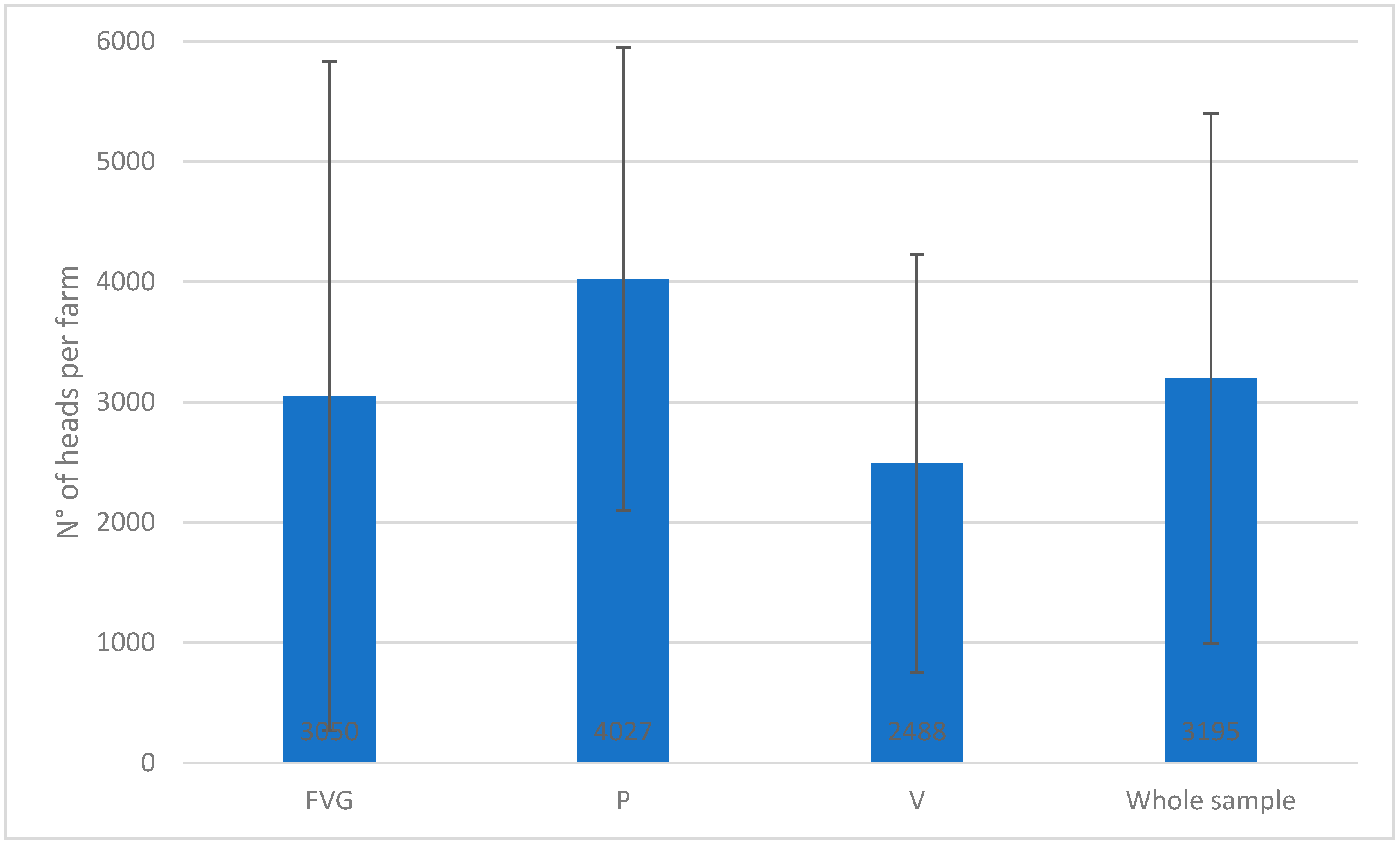

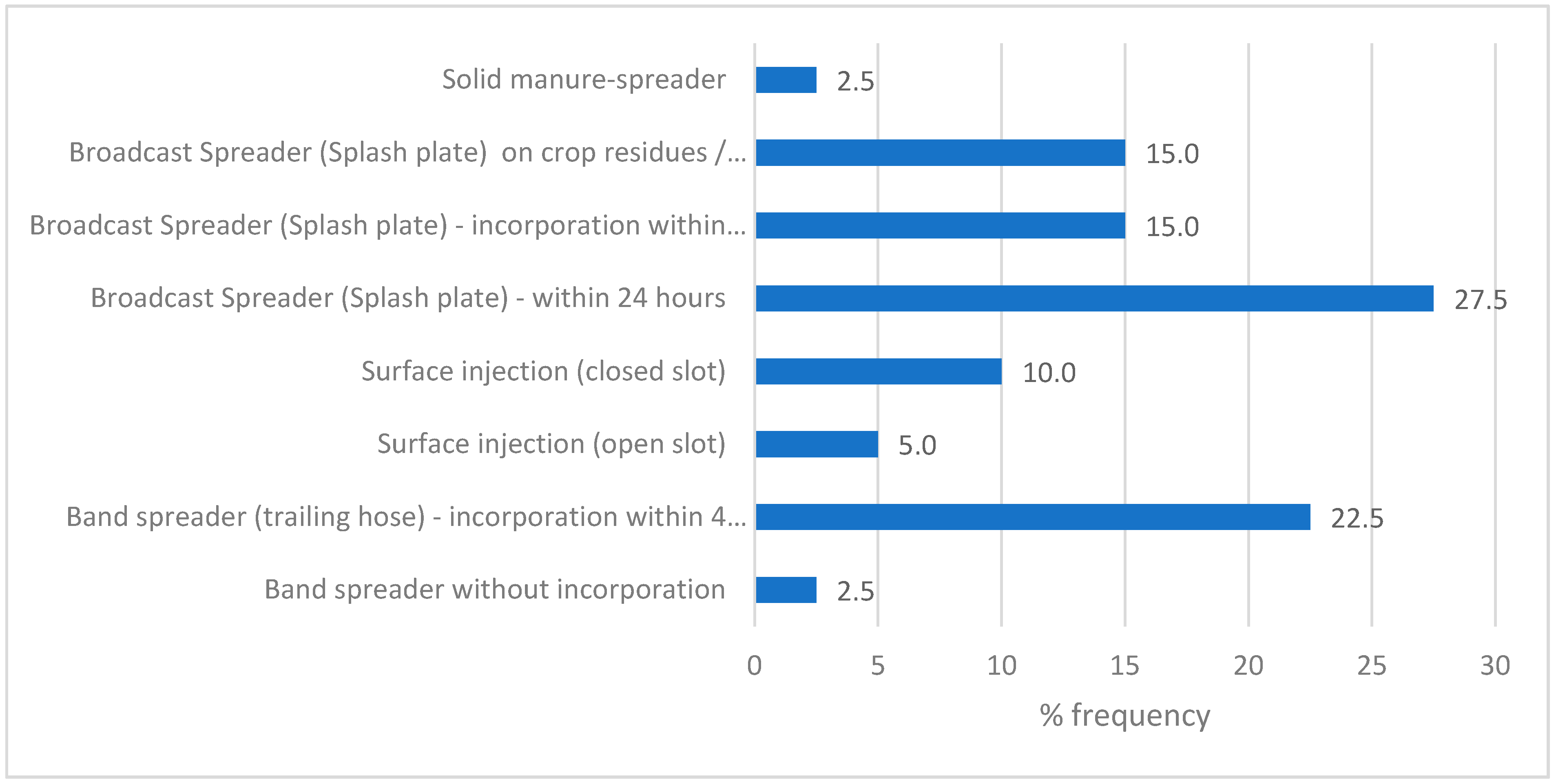

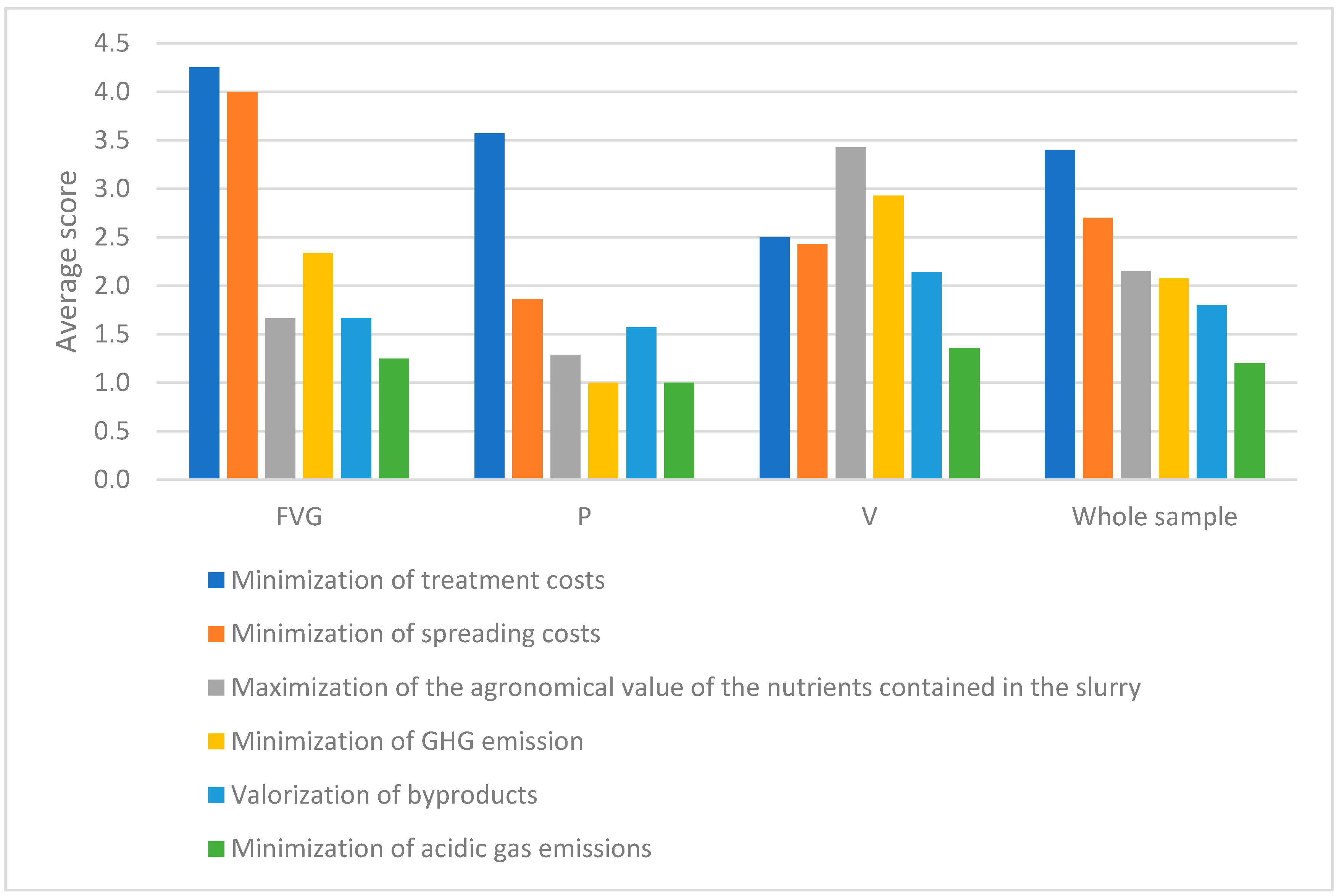

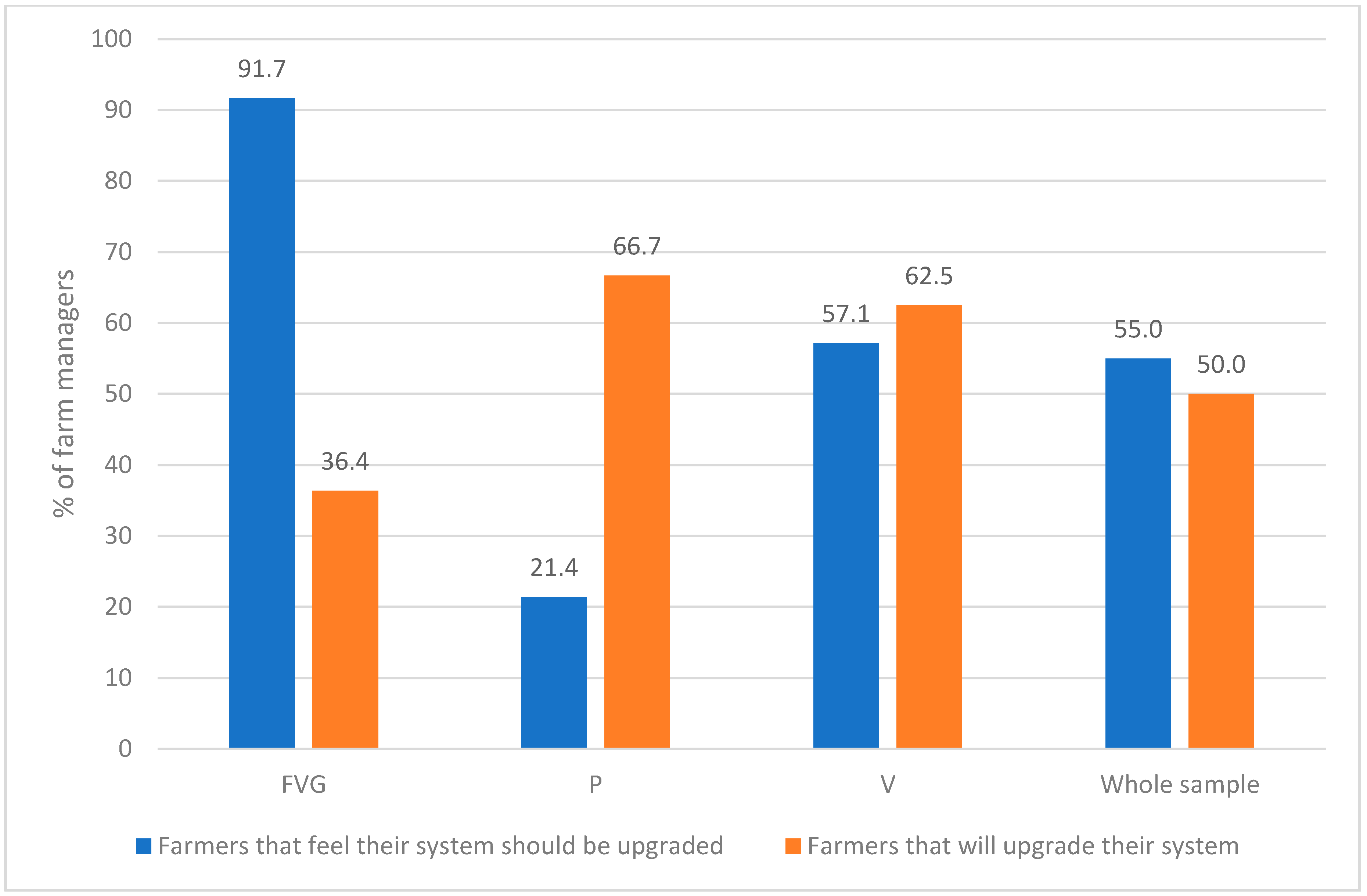
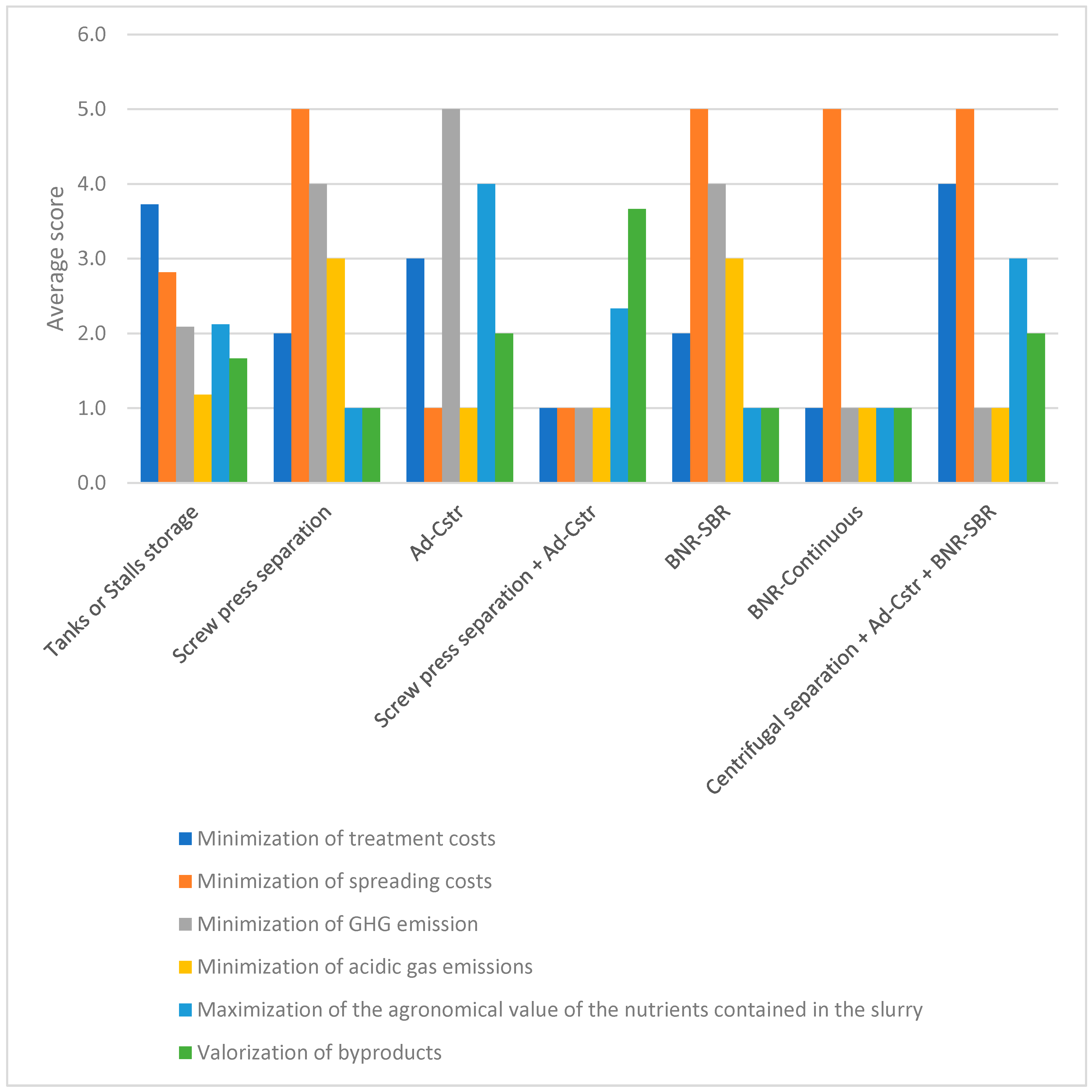
| Question Topic | N° and Type of Question |
|---|---|
| 6 open questions |
| 8 open questions (for each plot) |
| 6 open questions (for each building) |
| 5 open questions (for each structure) |
| 17 alternatives in multiple checkboxes |
| open question (up to 3) |
| open question (up to 3) |
| 6 alternatives assessed through personal 1 to 5 scoring |
| 4 alternatives in multiple checkboxes |
| y/n question |
| open question |
| y/n question |
| 6 open questions (for each plot) |
| y/n question |
Publisher’s Note: MDPI stays neutral with regard to jurisdictional claims in published maps and institutional affiliations. |
© 2021 by the authors. Licensee MDPI, Basel, Switzerland. This article is an open access article distributed under the terms and conditions of the Creative Commons Attribution (CC BY) license (http://creativecommons.org/licenses/by/4.0/).
Share and Cite
De Marinis, P.; Ferrari, O.; Allisiardi, E.; De Mattia, C.; Caliandro, G.; Dinuccio, E.; Borin, M.; Ceccon, P.; Sali, G.; Provolo, G. Insights about the Choice of Pig Manure Processing System in Three Italian Regions: Piemonte, Friuli Venezia Giulia, and Veneto. Sustainability 2021, 13, 787. https://doi.org/10.3390/su13020787
De Marinis P, Ferrari O, Allisiardi E, De Mattia C, Caliandro G, Dinuccio E, Borin M, Ceccon P, Sali G, Provolo G. Insights about the Choice of Pig Manure Processing System in Three Italian Regions: Piemonte, Friuli Venezia Giulia, and Veneto. Sustainability. 2021; 13(2):787. https://doi.org/10.3390/su13020787
Chicago/Turabian StyleDe Marinis, Pietro, Omar Ferrari, Erica Allisiardi, Chiara De Mattia, Giuliana Caliandro, Elio Dinuccio, Maurizio Borin, Paolo Ceccon, Guido Sali, and Giorgio Provolo. 2021. "Insights about the Choice of Pig Manure Processing System in Three Italian Regions: Piemonte, Friuli Venezia Giulia, and Veneto" Sustainability 13, no. 2: 787. https://doi.org/10.3390/su13020787
APA StyleDe Marinis, P., Ferrari, O., Allisiardi, E., De Mattia, C., Caliandro, G., Dinuccio, E., Borin, M., Ceccon, P., Sali, G., & Provolo, G. (2021). Insights about the Choice of Pig Manure Processing System in Three Italian Regions: Piemonte, Friuli Venezia Giulia, and Veneto. Sustainability, 13(2), 787. https://doi.org/10.3390/su13020787








